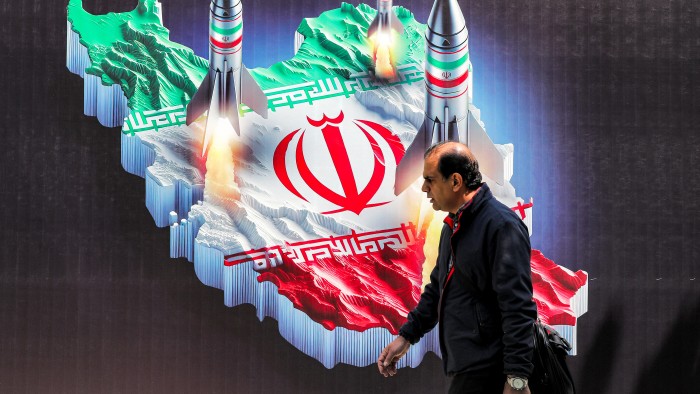As Donald Trump huddles with advisers in the White House’s situation room weighing whether to join Israel in striking Iran, the US president will also be considering how Tehran might retaliate.
Iran’s Supreme Leader Ayatollah Ali Khamenei has warned Washington of “irreparable damage” if the US joins in Israel’s war on the Islamic republic.
That could include direct attacks on US forces or diplomatic missions in the Middle East, cyber attacks, terrorism, strikes by Tehran’s proxies in the region, or disruption to shipments of oil and gas out of the Gulf, the world’s biggest energy-exporting region, said former US national security officials.
“Trump is likely hearing the list of options open to the Ayatollah: attacking US ships and bases, or attacking US Gulf allies such as Saudi Arabia or the United Arab Emirates,” said Elliott Abrams, who was the special representative for Iran and Venezuela in the first Trump administration.
A third option for Iran, Abrams said, was to “close” the Strait of Hormuz, the narrow waterway through which a third of the world’s seaborne crude passes each day. That would “[raise] world oil prices immediately”, he said.
Since rushing back to Washington from the G7 summit in Canada on Monday night, Trump has met his top intelligence, security and defence advisers twice in the situation room, the president’s intelligence nerve centre in the White House’s West Wing. He is due to have a third meeting on Thursday. A decision has not yet been made on whether the US will fully join the war.
On Wednesday, six days after Israel launched its assault on Iran, Trump said the next week would be “very big” in determining the course of the new conflict — and whether the US would get involved.
“I have ideas as to what to do, but I haven’t made a final, I like to make a final decision one second before it’s due . . . because things change . . . especially with war,” he told reporters in the Oval Office.

As he spoke, US military assets, including a new aircraft carrier group, were on their way to the Middle East.
But Iran was “prepared now” for a counterstrike against the US, with a “range of ballistic missiles, cruise missiles and drones” available that it could use to hit American bases and ships, said former air force secretary Frank Kendall.
That did not mean it would do so immediately, Kendall said. It would be “an escalation question” for the Iranians, he added, and “a calculation of what additional attacks would be remounted if they responded” to the US.
The US has approximately 40,000 troops and military personnel in the Middle East, according to a US defence official. It operates eight permanent bases in the region, in Bahrain, Kuwait, Qatar and the UAE. It also has a presence at 11 other military sites, including in Egypt, Iraq, Jordan, Oman, Saudi Arabia and Syria.
The biggest US base is Al Udeid Air Base in Qatar, the regional headquarters for US Central Command, which is responsible for military operations throughout the Middle East. The base houses about 10,000 US troops. Another 13,500 or so troops are in Kuwait, while a further 9,000 reside at the US naval base in Bahrain.
Iran could target the sites and bases in the UAE, Qatar, Saudi Arabia, Iraq and Kuwait, said Kendall. These are equipped with aerial defences, but are within closer range of Iran than Israel, meaning shorter-range missiles could be used and there would be less warning time.
“They’re always on a reasonable set of alert because of potential attacks, but I would assume [it] would be higher 1750334256,” he said.
The US also has about 2,500 troops in Iraq and hundreds in Syria. These personnel could be vulnerable to attacks from Iranian-backed Shia militants — who have in the past fired rockets and drones at US assets and troops — as well as from Iran’s missiles.

Another risk Trump must consider is that the US could fail to destroy Fordow, the Iranian nuclear facility buried half a kilometre beneath a mountain.
Fordow is one of Iran’s two main uranium enrichment facilities and the US and Israel consider its destruction key to eliminating the republic’s nuclear programme. Iran says the programme is for civilian purposes.
Demolishing the subterranean facility could involve the US dropping 30,000-pound “bunker buster” bombs from stealth bombers.
But the mission would be laced with risk — and could fail.
If so, Fordow would be likely to “remain a challenge for non-proliferation efforts”, Heather Williams, director of the Project on Nuclear Issues at the Center for Strategic and International Studies think-tank, said in a note.
Iran could also regroup and be more determined to covertly develop a nuclear weapons programme. The republic was already enriching uranium to levels close to weapons grade.
“Any additional damage would set them back perhaps years, but it would not stop them from reconstituting or continuing a programme to acquire nuclear weapons,” said Kendall.
Iran could also strike back with punishing economic effect by targeting energy supplies out of the Gulf.
In 2019, the vulnerabilities were exposed when a missile and drone attack blamed on Iran temporarily knocked out half of Saudi Arabia’s crude oil output. Saudi Arabia and other Gulf states have in recent years engaged in a détente with Iran, seeking to reduce tensions and ward off more strikes.
In the Strait of Hormuz, Iran could use fast-attack boats, submarines and land-based anti-ship weapons to strike sailing ships, said Kendall. Alternatively, it could mine the waterway.
But Iran also uses the strait for its own oil exports, its key source of foreign currency. That could reduce the risk of Tehran targeting the strait, but ships would still be “vulnerable to attack”, added Kendall.
Since Hamas’s October 7 2023 attack on Israel, Iran-backed Houthis in Yemen have already severely disrupted maritime traffic through the Red Sea and Gulf of Aden, despite months of air strikes by the US targeting the group.
Helima Croft, a former CIA analyst and global head of strategy at RBC Capital Markets, said she was worried about the vulnerability of Iraq, which produces 4mn barrels of oil a day. Infrastructure in Basra was threatened by “Iranian-backed militias that operate very close to those facilities”, she told the Atlantic Council Global Energy Forum on Wednesday.
Other experts said they thought Israel’s bombardment, which has killed many of Iran’s top military commanders and destroyed missile launchers and plants, had sufficiently weakened Iran’s ability to retaliate against the US.
Israel has destroyed most of Iran’s air defences in recent days and has almost total air dominance over the republic, which could help persuade the US to strike.
Iran’s main proxy, Lebanese militant movement Hizbollah, has also been severely debilitated after Israel launched a series of devastating assaults on the group last year.
There would be “major drawbacks” to Iran using missiles and drones to retaliate, said Erik Raven, former under-secretary of the US Navy.
“Their stockpiles are depleting [and] American missile defence systems are highly capable,” he added. “There is no chance of these attacks achieving any of their political goals. The calculation is all risk, no reward.”
Brett McGurk, the White House co-ordinator for the Middle East under Joe Biden, said the US had been planning and training for a potential Fordow mission for “10 or 15 years”.
Plans were refined in the last two years of Biden’s presidency, he said, and “the window of ability for a military option is now very open”.








